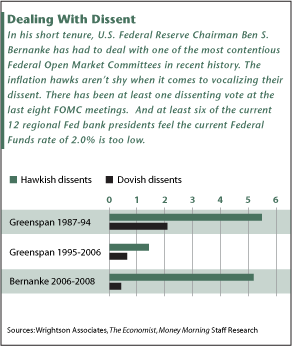By Jennifer Yousfi
Managing Editor
Already forced to deal with the competing and contradictory challenges of a slowing economy and escalating inflation, U.S. Federal Reserve policymakers will now also have to factor a deteriorating labor market and big drop-off in consumer spending into their interest-rate deliberations when they meet tomorrow (Tuesday).
“There's a big question mark over the performance of the economy over the next six months,” John Lonski, chief economist at Moody's Investors Service Inc. (MCO) in New York, told Bloomberg News. “We have to be braced for a decidedly slower pace of consumer spending.”
Only a month ago, the economic outlook was much more upbeat.
“It may have felt like a recession to many, but the economy actually expanded quite solidly in the spring,” Joel Naroff, president and chief economist of Naroff Economic Advisors, said in a research note to clients after the release of the revised second quarter gross domestic product (GDP) report.
The U.S. economy expanded at a 3.3% rate in the second quarter, fueled by government stimulus checks. The surprising rate of growth, coupled with high commodity prices, led some to believe the rate-setting Federal Open Market Committee (FOMC) would reverse course and adopt a more-hawkish monetary policy as it opted to battle inflation.
“A number of participants worried about the possibility that core inflation might fail to moderate next year unless the stance of monetary policy was tightened sooner than currently anticipated by financial markets,” according to the minutes of the Federal Open Market Committee’s Aug. 5 meeting released late last month.
Last Sept. 18 – faced with the very real concern that the growing global credit crunch could cause a worldwide market meltdown – the FOMC voted to slash the Federal Funds Rate by a hefty – and surprising – half a percentage point, taking the benchmark borrowing rate from 5.25%. It was the first rate cut in four years, and prompted the biggest single-day stock-market rally in five and a half years. Investors responded to the “super-sized” rate cut by sending the Dow Jones Industrial Average up nearly 336 points.
All told, the Fed’s aggressive rate-cutting campaign resulted in a total of seven rate cuts, bringing the Fed Funds rate from its initial 5.25% all the way down to its current level of 2.0%. Since, then the FOMC has kept the benchmark rate at 2.0% for two straight meetings.
But the agreement to hold rates steady certainly doesn’t mean there’s been unanimous thinking. Indeed, what had been fractious internal debate has spilled over into the public domain. The result: Fed Chairman Ben S. Bernanke has several members of the FOMC that have been quite vocal with their dissent of the central bank’s dovish stance.
Dallas Fed President Richard Fisher has repeatedly lobbied for a more hawkish stance on inflation and voted to raise the key interest rate at the last meeting.
“While the financial system remained fragile and economic growth was sluggish and could weaken further, [Fisher] saw a greater risk to the economy from upward pressures on inflation,” the minutes read.
Richmond Fed President Jeffrey Lacker, who is not a current member of the FOMC, has also repeatedly criticized the Fed’s current monetary policy and penchant for bailing out troubled financial institutions.
Still, with 10 members of the committee having voted to hold rates steady at its last meeting, and only one member voting to increase rates, it seems likely the FOMC will hold rates steady into 2009 before making future moves.
A fresh round of indicators demonstrate the domestic economy is getting weaker and a rate hike seems highly unlikely. In fact, if things continue to deteriorate, further easing might not be out of the question.
The stimulus checks are spent and gone and the outlook for third quarter GDP is far gloomier. Consumer spending provides almost two-thirds of GDP. And despite an easing in commodity prices, particularly oil and gas, Americans just aren’t spending the way they used to.
The Commerce Department announced that U.S. retail sales fell 0.3% in August, on the back of a 0.5% decline in July.
“By July, essentially all the rebates had already been distributed, and so were no longer providing support to incomes,” Goldman Sachs Group Inc. (GS) economist Seamus Smyth said in a note to clients, Bloomberg reported. “Combined with weak job growth and tight credit, consumers had no way to fund additional consumption.”
Unemployment ticked up 0.4% in August, reaching 6.1%. It’s unlikely the Fed would vote to raise rates with unemployment to so high.
Plus, there was good news on the inflation front. August’s Price Producer Index (PPI) dropped 0.9% for the month due to the huge drop in energy prices from July record highs. With oil receding from record highs and producer inflation easing, consumer inflation could see a similar decrease.

“This report should help those who will argue at Tuesday’s FOMC meeting that inflation is not yet such a threat that the rate has to be hiked,” Joel Naroff said. “There will be time to do that, but not until the financial and housing sectors show some stability.”
The domestic economy is certainly winding down. But the Fed will likely take a wait and see approach for now to determine if weak economic growth is having the hoped for curtailing effect on inflation.
News and Related Story Links:
-
Bloomberg News:
Retail Sales in U.S. Unexpectedly Dropped in August
-
The Economist:
The Federal Reserve: When hawks cry
-
DailyFX.com:
US Inflation Pressures Cool And Trade Shortfall Grows
-
Money Morning:
Fed Signals Next Move Will be a Hike in Rates, But Timing Remains Uncertain. -
Wikipedia:
Federal Open Market Committee. -
Money Morning News Analysis
: Super-Sized Rate Cut Spurs Super-Steep Rally; Dow Soars Nearly 336 Points.


